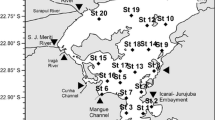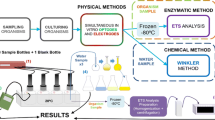Abstract
A method is outlined for the measurement of NADH2-dependent dehydrogenase activity in whole samples as well as in fractions of carbonate sediments. The method is based on extraction of enzyme activity with phosphate buffer containing 0.12% Triton X-100, dialysis, and a photometric assay which permits initial velocity determinations of the enzyme reaction under controlled conditions of pH, temperature, and substrate concentration. The dehydrogenases extracted from carbonate sediment of a subtropical beach at Bermuda are characterized by low K m values (0.03 to 0.07 mM NADH2/1), pH maxima around 8.5, and temperature maxima between 35° and 40°C. Their vertical distribution in the sediment agrees with what is known about the distribution of biomass on beaches of this type, maximum activity occurring in the topmost centimetre. Approximately 80 to 90% of the total electron transport activity is contained in the grain fraction, the remainder in the interstitial fraction of a sediment sample. From this it can be inferred that the interstitial fauna contributes only little to the total energy budget of this type of sediment, which is dominated by the “Aufwuchs” on the sand grains. The electron transport activity (ETA) measured by means of the dehydrogenase assay is taken to represent the maximum transport capacity (ETC) of all the organisms living in the sand ecosystem. From published evidence it is inferred that oxygen consumption of sediment samples and of individual organisms measured in vivo usually accounts for 10 to 20% of the maximum electron transport capacity measured in vitro with saturating concentrations of substrates and with Triton X-100 as part of the enzyme assay. It is suggested further that the ratios of dehydrogenase activities in different fractions or zones of sediment, or of different organisms, may represent one of the best indicators, so far available, of energy relationships in marine sediments.
Similar content being viewed by others
Literature Cited
Chance, B.: Reaction of oxygen with the respiratory chain in cells and tissue. J. gen. Physiol. 49, 163–188 (1965)
Curl, H.C., Jr. and J. Sandberg: The measurement of dehydrogenase activity in marine organisms. J. mar. Res. 19, 123–138 (1961)
Dolin, M.I.: Survey of microbial electron transport mechanisms. In: The Bacteria. Vol. II. Metabolism, pp 319–363. Ed. by I.C. Gunsalus and R.Y. Stanier. New York: Academic Press 1961
Fenchel, T.: The ecology of marine meiobenthos. I. The quantitative importance of ciliates as compared with metazoans in various types of sediments. Ophelia 4, 121–137 (1967)
— and R.J. Riedl: The sulfide system: a new biotic community underneath the oxidized layer of marine sand bottoms. Mar. Biol. 7, 255–268 (1970)
Gerlach, S.A.: On the importance of marine meiofauna for benthos communities. Oecologia 6, 176–190 (1971)
Green, D.E. and D.H. MacLennan: The mitochondrial system of enzymes. In: Metabolic pathways, 3rd ed. Vol. I. pp 48–111. Ed. by D.M. Greenberg. New York: Academic Press 1966
Hammen, C.S.: Succinate and lactate oxidorductases of bivalve mollusks. Comp. Biochem. Physiol. 50B, 407–412 (1975)
Hochachka, P.W. and T. Mustafa: Invertebrate facultative anaerobiosis. Science, N.Y. 178, 1056–1060 (1972)
Jansson, B.O.: Factors and fauna of a Baltic mud bottom. Limnologica (Berlin) 7, 47–52 (1969)
Kenner, R.A. and S.I. Ahmed: Measurements of electron transport activities in marine phytoplankton. Mar. Biol. 33, 119–127 (1975a)
——: Correlation between oxygen utilization and electron transport activity in marine phytoplankton. Mar. Biol. 33, 129–133 (1975b)
King, F.D. and T.T. Packard: Respiration and the activity of the electron transport system in marine zooplankton. Limnol. Oceanogr. 20, 849–854 (1975)
Lenhard, G.: Die Dehydrogenaseaktivität des Bodens als Mass für die Mikroorganismentätigkeit im Boden. Z. Pfl-Ernähr. Düng. Bodenk. 73, 1–11 (1956)
—: Dehydrogenase activity as criterion for the determination of toxic effects on biological purification systems. Hydrobiologia 25, 1–8 (1965)
Maeda, M. and N. Taga: Deoxyribonuclease activity in seawater and sediment. Mar. Biol. 20, 58–63 (1973)
Owens, T.G. and F.D. King: The measurement of respiratory electron-transport-system activity in marine zooplankton. Mar. Biol. 30, 27–36 (1975)
Packard, T.T.: The measurement of respiratory electron-transport activity in marine phytoplankton. J. mar. Res. 29, 235–244 (1971)
—, D. Harmon and J. Boucher: Respiratory electron transport activity in plankton from upwelled water. Tethys 6, 213–222 (1974)
— and M.L. Bealy: Electrochemical standardization of the dehydrogenase assay used in the estimation of respiration rates. J. mar. Res. 26, 66–74 (1968)
—— and F.A. Richards: Vertical distribution of the activity of the respiratory electron transport system in marine plankton. Limnol. Oceanogr. 16, 60–70 (1971)
Palmer, J.D.: Biological clocks in marine organisms, 173 pp. New York & London: John Wiley & Sons 1974
— and T.E. Round: Persistent vertical migration rhythms in benthic microflora. VI. The tidal and diurnal nature of the rhythm in the diatom Hantzschia virgata. Biol. Bull. mar. biol. Lab., Woods Hole 132, 44–55 (1967)
Pamatmat, M.M.: Ecology and metabolism of a benthic community on an intertidal sandflat. Int. Revue ges. Hydrobiol. 53, 211–298 (1968)
— and A.M. Bhagwat: Anaerobic metabolism in Lake Washington sediments. Limnol. Oceanogr. 18, 611–627 (1973)
— and H.R. Skjoldal: Dehydrogenase activity and adenosin triphosphate concentration of marine sediments in Lindaspollene, Norway. Sarsia 56, 1–12 (1974)
Raymont, J.E.G., S. Krishnaswamy and J. Tundisi: Biochemical studies on marine zooplankton. IV. Investigations on succinic dehydrogenase activity in zooplankton with special reference to Neomysis integer. J. Cons. perm. int. Explor. Mer 31, 164–169 (1967)
Smith, K.L., Jr., K.A. Burns and J.M. Teal: In situ respiration of benthic communities in Castle Harbor, Bermuda. Mar. Biol. 12, 196–199 (1972)
Stevenson, I.L.: Dehydrogenase activity in soils. Can. J. Microbiol. 5, 229–235 (1959)
Teal, J. and W. Wieser: The distribution and ecology of nematodes in a Georgia salt marsh. Limnol. Oceanogr. 11, 217–222 (1966)
Vernberg, W.B. and B.C. Coull: Respiration of an interstitial ciliate and benthic energy relationships. Oecologia 16, 259–264 (1974)
Wieser, W.: The meiofauna as a tool in the study of habitat heterogeneity: ecophysiological aspects. A review. Cah. Biol. mar. 16, 647–670 (1975)
— and J. Kanwisher: Ecological and physiological studies on marine nematodes from a small salt marsh near Woods Hole, Massachusetts. Limnol. Oceanogr. 6, 262–270 (1961)
—, J. Ott, F. Schiemer and E. Gnaiger: An ecophysiological study of some meiofauna species inhabiting a sandy beach at Bermuda. Mar. Biol. 26, 235–248 (1974)
Author information
Authors and Affiliations
Additional information
Communicated by O. Kinne, Hamburg
Contribution No. 652 from the Bermuda Biological Station for Research.
Rights and permissions
About this article
Cite this article
Wieser, W., Zech, M. Dehydrogenases as tools in the study of marine sediments. Mar. Biol. 36, 113–122 (1976). https://doi.org/10.1007/BF00388434
Accepted:
Published:
Issue Date:
DOI: https://doi.org/10.1007/BF00388434




